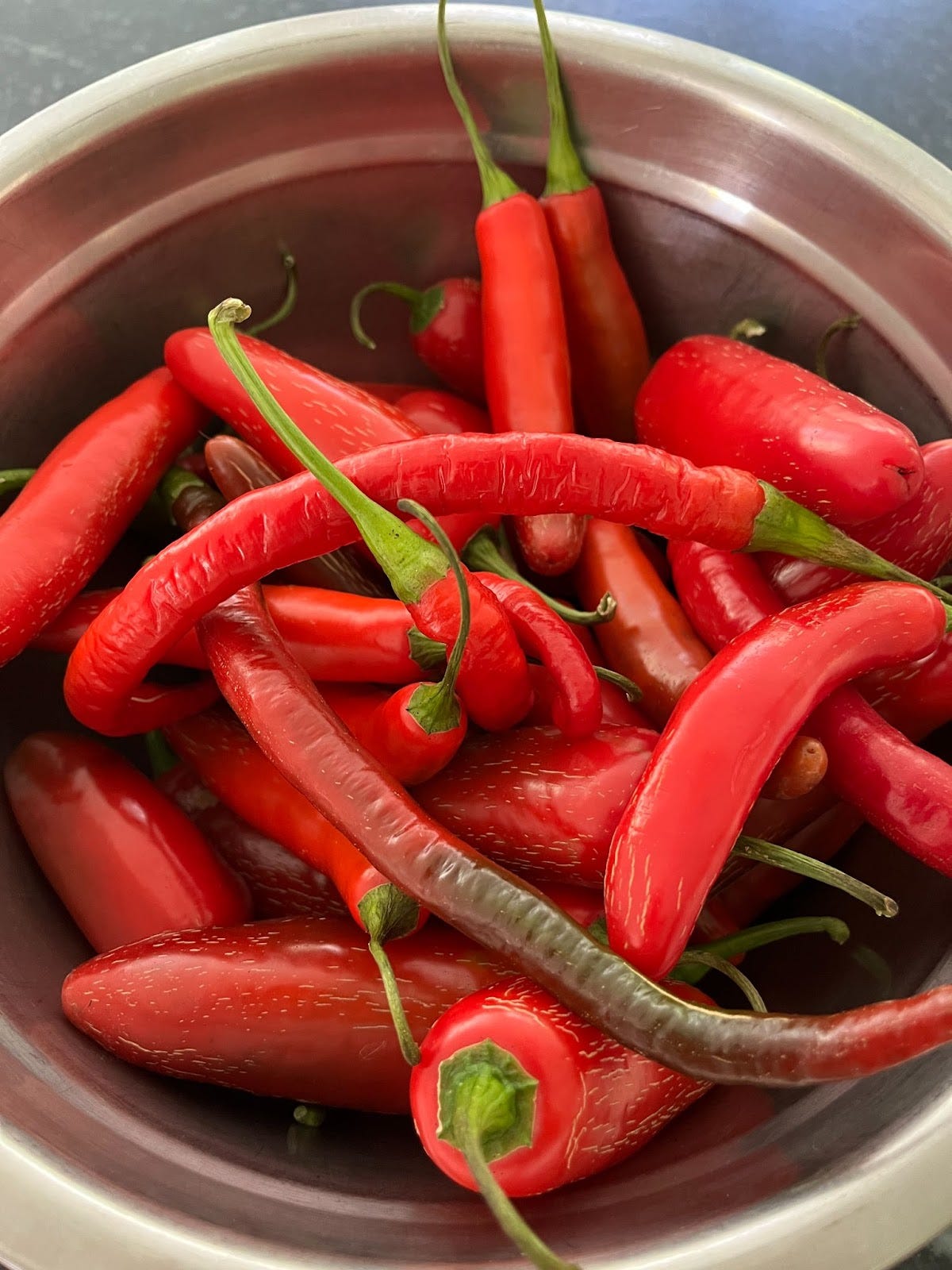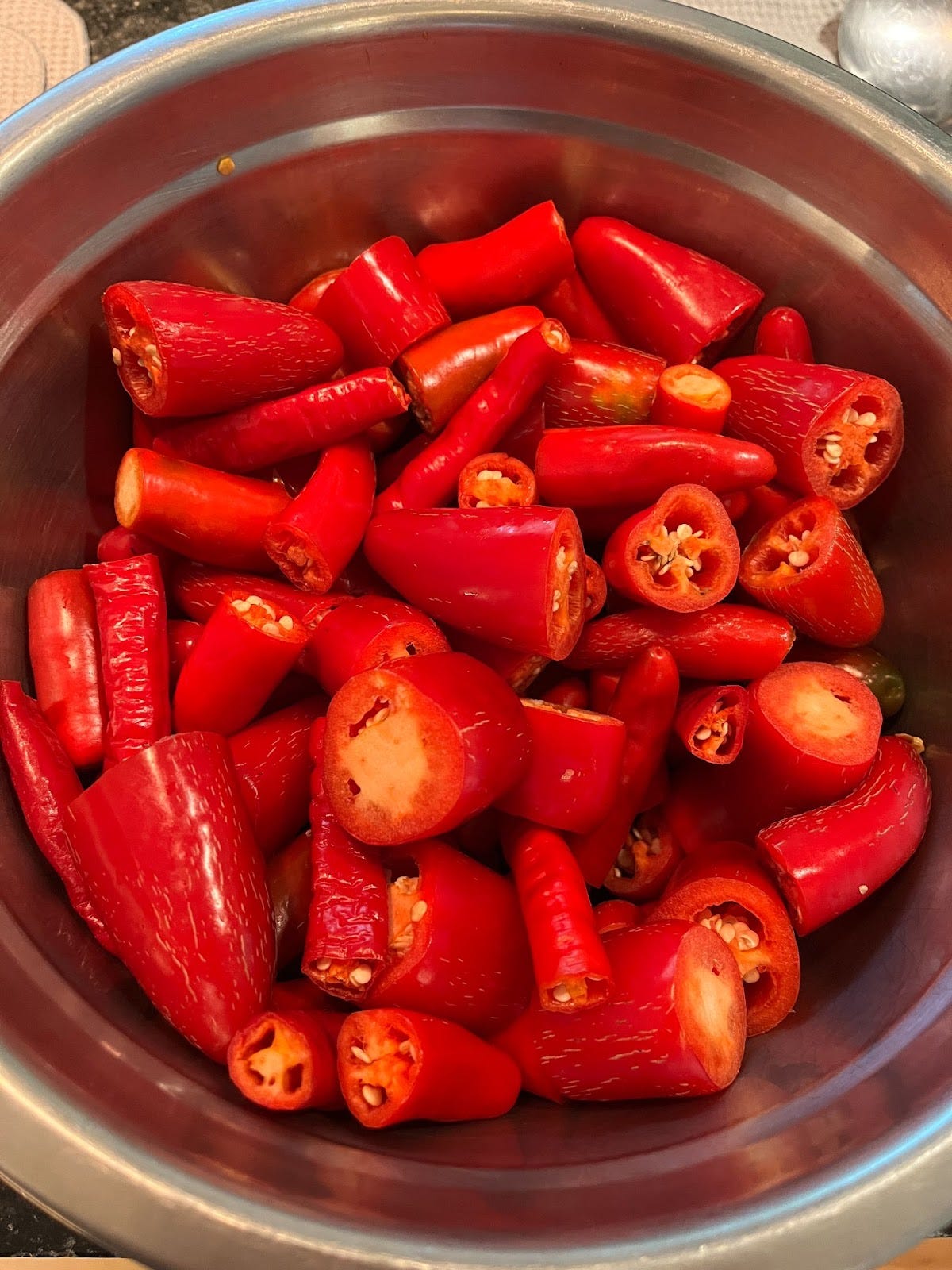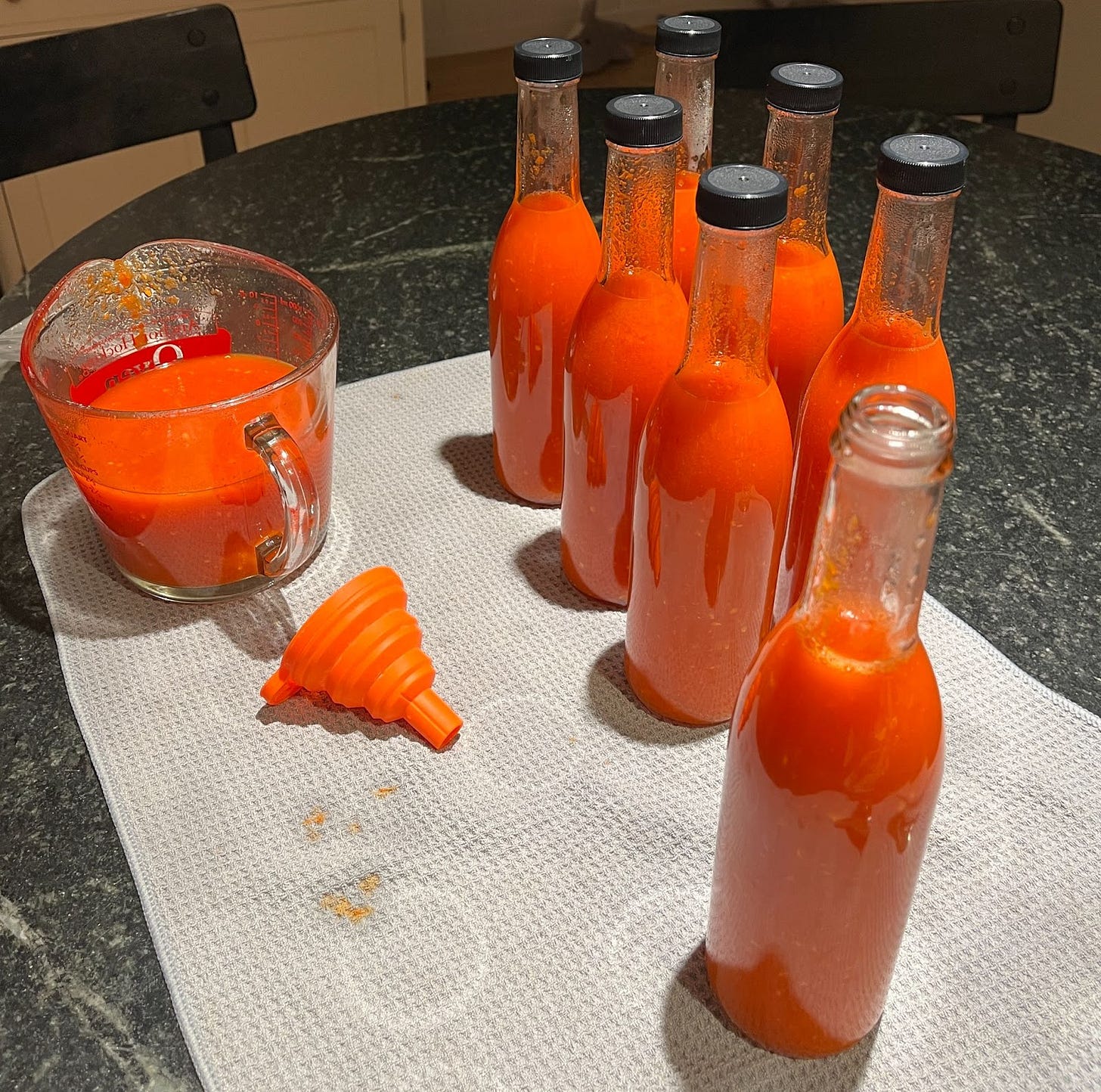
Sap is running in the sugar bush, the ground is loosening with rain and warmth, and I’m soaking my first round of garden seeds. I have observed the rites of spring planting for most of my life, and I know of no more hopeful ceremony.
There is always some dreaming involved, a little picture making about the patterns I’ll create with Black Magic, Winterbor, and Redbor kale. How I’ll train the Sashimi cucumbers up a trellis, so the gherkins can fatten in midair. How a white hibiscus might look against the side of the greenhouse.
This week I’m dreaming about peppers. They grow slowly, so I start them first, soaking the seeds overnight and planting trays the next day. My favorite is Joe’s Long Cayenne, an heirloom from Seed Savers Exchange that a friend calls “witch’s fingers.” These peppers dry up nicely for red pepper flakes, but I especially like them for homemade hot sauce, which I make in such large quantities every year that it feels a little like sorcery.
If you’d like to brew your own batch of Louisiana-style sauce, read on for my recipe. But I also want to think a little about the food arts and why even something like hot sauce, a culinary afterthought — a condiment, for God’s sake — strikes such a deep chord with me.

Part of it is that growing food ties me to a place. Even if gardening requires ripping out the old, making it new, imagining how it could be, a fresh growing season reminds me of the longer arcs of natural history, what shaped the soil and streams, and of human communities, how many hands the land has passed through. And so my garden moves forward and back in time, recalling how it was and who entrusted this ground to me.
I know from neighbors that the previous owner of my new home was also divorced. But before he and his wife parted ways, they built a garden together. He tended the vegetable beds, pieced a greenhouse together from salvaged materials, and carted in rocks for a koi pond. She reclaimed huge swaths of yard with perennial beds, with the daffodils and ferns now sprouting new shoots, and many other grasses and shrubs that will reveal themselves slowly, like panels opening in an advent calendar, all through the spring.
After she left, he tended the grounds alone, plying the neighbors with surplus zucchini and corn, as I surely will do. I wonder if the hardest part of selling the place for him was leaving the garden behind, wondering whether a new owner might till it all under, turn it all back to grass. Call me sentimental, but I found a way to get word to him in his retirement community that I was excited to pick up where he left off, that he could rest in the knowledge that his vegetable beds had fallen in good hands.
I like knowing that this garden was a place where two people carried their hurt, where they each grew beautiful things out of their pain, and where one of them carried on alone, as I will do. I feel a kinship with that pain and also with the impulse to transform it into flowers and potatoes and beans.
My Iowa garden once belonged to the estate of the town’s founder, Domine Scholte, who brought his young wife, Mariah, from the Netherlands to the frontier, where he built her a large house and placed the rest of their acreage in her care. But their relative comfort did little to ease Mariah’s loneliness. She was a reluctant pioneer. Her china was smashed in transit, so she lined her garden paths with the shards of those teacups, saucers, and plates. She also suffered many miscarriages and buried the remains among her roses.
I unearthed Mariah’s china fragments while turning my own garden beds, and I kept them in a row on the window sill. I’d think of Mariah while watering my zinnias, while picking green beans, while pruning my golden raspberry canes. Those shards reminded me that gardens are good places for grieving. You can trust your deepest hurt to the shade of an apple tree. You can postpone your wish for death by digging a furrow, filling it with purple potato cuttings, and mounding it like a grave, knowing that the end of the story will be resurrection.
My peppers tell the same tale. Joe’s Long Cayenne went by a different name in Calabria, Italy, for hundreds of years before immigrants brought it to Toronto. A man named Joe Sestito (for whom the heirloom is now named) carried the seeds to Troy, New York, where Dr. Carolyn Male discovered them in 1996. Seed Savers Exchange has now kept the variety alive for nearly 30 years.
And so it is hard for me to think of my hot sauce as a condiment. It is a story to tell, a touchstone for history, a tradition to pass down. In that way, my sauce is not even mine — if it belongs to anyone, it is to a gardener yet unborn, or to the craft of husbandry itself.
How to Make Your Own Hot Sauce
I’ve experimented with many recipes, and if you like smoky notes in your sauce, Chantelle’s recipe at Naked Cuisine will make a tasty blend of tomatoes, garlic, and chiles.
But the most savory sauce is fermented, and I learned that particular sorcery from Robb Walsh’s Hot Sauce Cookbook. Since I can’t hand my extra zucchini over the fence to you, I’ll share my method for making a year’s worth of my own Tabasco-style sauce.

The first step toward the best hot sauce of your life is the pepper itself. You want the fruit to turn red, perhaps even to soften a little on the bush, before you harvest it. Even jalapeños will turn red if you let them ripen long enough, so patience is key.
If you live in a warm place with low humidity, you might spread your peppers out to cure in the sun. But I live in a rainy place with high humidity, so I leave my peppers in a bowl by the window for a day or two until the flesh begins to soften. Then I speed up the process by baking the peppers at about 200 degrees, removing them just as they begin to wrinkle.
Once the peppers are soft, coat them with salt in a big mixing bowl and use a potato masher to crush the flesh. Mash everything up good, until you can see some liquid gathering in the bottom, cover with a towel, and leave overnight.
After the pepper mash has cured for at least one day, pack it into Mason jars. Cover the mash with water, leaving at least 1” head space. I like to use pickle pipes (pictured below), but any solid lid will do as long as the gas is vented every day or two.

Robb Walsh recommends whittling a cabbage core down and stuffing it into the mouth of the jar to keep the pepper mash submerged. Pickle pipes come with glass weights that can serve the same purpose.
Leave the jars at room temperature for two weeks. A shorter fermentation time would yield a milder flavor, and fermenting longer (up to four weeks) would do the reverse. I prefer the flavor notes at two weeks.
Whatever fermentation window you choose, you’ll need a blender, a funnel, bottles (or jars), white vinegar, and peeled garlic for the next step.
I prefer a 1:1 mash to vinegar ratio. Adding slightly more vinegar would work better if you use a dropper in your bottles. If you prefer a paste-like texture, like sriracha, add more mash to the mix.
Transfer the fermented mash directly from your jars into the blender (no draining, because you want to keep the salt). Add vinegar based on desired texture. Add 1-2 heads of peeled garlic. Puree until no chunks remain.
Swing-top bottles work great if you plant to refrigerate the batch. Canning jars in a boiling bath works fine for longer-term storage. Or do some research on Plastisol lids and hot packing if you’d prefer a more elegant shelf-stable option.
I close with a meditation on how hot sauce making, like every other food tradition passed down through generations, is a form of memory. Every step of the process, from saving the cayenne variety that somehow picked up Joe Sestito’s name, to the simple implements required (a glass jar and funnel), to trusting nothing but air, water, and microbes to transform the flavor of the mash, adds to the ritual.
Some say we die a second death the moment we vanish from the memories of the living. I like the idea that I’m linked hand-in-hand with everyone in this historical chain from Iowa to New York to Toronto, all the way back to Calabria, Italia. That sense of connection is why gardens are good for the grieving. The core of grieving is remembering, and gardens are memory shrines. We go there to shore up our ruins, to restore our faith that something bright and beautiful can still rise from our ashes.
Please consider subscribing to The Recovering Academic to unlock more essays, interviews, and craft resources. If this essay resonated with you, or if you found the recipe helpful, you can also leave a tip in appreciation. Thanks in advance!








I will send this to my wife who loves hot sauce. She views her taste buds as a superpower, able to withstand the spiciest of the spicy.
Beautiful! If there's one regret I have about leaving, it's that I missed out on the hot sauce industry that had begun to follow in the footsteps of craft beer. You touch on something immensely profound in a time of great fear, pain and strife: we love this condiment and its spice so much, but why? As you pointed out, it's "just" a condiment. The resonance of pain and meaning (paired with the pastime of gardening) is probably the best explanation I've encountered. To be sure, it's also the only one: but it's hard to surpass this one.
I think Karel Capek, author of that most Czech book on gardening, the Gardener's Year (which is in English translation) would have very much enjoyed this post.